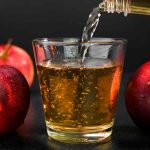What makes a fruit tree ideal for containers? Size is a factor, of course, but so is the tree’s propensity for natural sunlight, along with its moisture requirements and its pruning demands. On a more sensory note, experts also consider the smell of a tree’s blossoms, as well as its visual appeal—and the sweetness of its fruit.
Here, we spoke with professional gardeners about their favorite fruit trees that thrive in containers and the care requirements for each. Their wisdom will help you choose the best plant for your outdoor space.
- Michael Kenins, an ISA-certified arborist and founder and CEO of Vista Tree Management in Toronto
- Tammy Sons, founder and CEO at TN Nursery
- Jen McDonald, a certified organic garden specialist and co-founder of Garden Girls
Dwarf Improved Meyer Lemon Tree
Getty / Ivan Halkin
The dwarf improved Meyer lemon tree does well in a container due to its naturally small size, and it yields sweet and juicy fruit. Its flowers self-pollinate, so one plant is plenty, but since container soil tends to lose moisture more quickly, your tree will need regular watering. Occasional pruning will also help to keep the plant’s structure intact.
Tammy Sons, founder and CEO of TN Nursery, describes the Meyer lemon as “highly productive” and “extremely fragrant.” However, it can’t stand up to a chill. “Gardeners will need to move their tree indoors during the winter months in cooler regions,” she says.
- Growing zones for containers: 4 to 11
- Size: 4 to 6 feet tall in containers
- Growing conditions: Full sunlight for six to 12 hours; moderate watering; well-draining, slightly acidic soil
Captivator Gooseberry
Avalon_Studio / Getty Images
While similar in size and texture to a grape, gooseberries are considered a specialty crop, and growing them can be very rewarding.
“This tree is compact, productive, and slightly wild and offers a nostalgic-yet-fresh vibe for cottage-inspired aesthetics or rustic spaces,” says Michael Kenins, an ISA-certified arborist and the founder and CEO of Vista Tree Management. “It produces lots of translucent berries that resemble miniature lanterns. They can be used in jams and desserts.”
It’s important to note that some gooseberry varieties can be susceptible to mildew and will therefore require good airflow. Others may even have thorns, so thornless trees like the captivator are quite popular.
- Growing Zones for containers: 3 to 8
- Size: 2 to 3 feet tall in containers
- Growing conditions: Partial sun; well-draining soil; consistent moisture
Clementine Mandarin Tree
Getty / Alex Tihonov
Dwarf varieties of clementine trees, such as the clementine mandarin tree, are adapted for small spaces and containers; they do well on patios or balconies that receive full sun.
“If you’re very limited on space, this might be a nice option, as it’s self-pollinating and doesn’t require a second tree to produce fruit,” says Jen McDonald, a certified organic garden specialist and co-founder of Garden Girls. “For this tree to thrive, you’ll want to plant it in an extra-large container with sandy, loamy soil.”
Additionally, this specific variety often provides its sweet and easy-to-peel fruit, while other fruit trees are still out of season, so it’s a welcome addition to any outdoor space.
- Growing zones for containers: 8 to 11
- Size: 8 to 10 feet tall (but can be kept smaller in a container with regular pruning)
- Growing conditions: Full sun; well-draining soil; consistent moisture
Pink Variegated Lemon Tree
Getty / Motionshooter
“The pink variegated lemon tree is a vibrant showstopper with bold, year-round foliage,” says Kenins. “Its compact size and tolerance for air pollution make it an excellent choice for urban and suburban homes.”
However, keep in mind that this semi-dwarf tree can be slightly more sensitive to the cold than standard lemon trees, so plan to bring it indoors if temperatures dip.
“The fruit is just as tart as regular lemons, but it has a pink juice similar to grapefruit, so it’s a unique addition for elevated drinks,” adds Kenins. “It’s a classic plant—with a bold update.”
- Growing zones for containers: 4 to 11
- Size: 3 to 5 feet tall in containers
- Growing conditions: Full sunlight for six to eight hours per day; well-draining, slightly acidic soil; moderate water
Indio Mandarinquat Semi-Dwarf Kumquat Tree
Getty / Christopher Aimes
The mandarinquat thrives in small spaces and produces clusters of bright orange fruit that’s larger and juicier than a kumquat and that’s fully edible—even the peel. “It requires little maintenance and is very heat tolerant with the right watering, which makes it good in urban or suburban environments,” Kenins says.
The plant is self-fertilizing; however, annual pruning is needed to maintain its shape. During the growing season, you’ll want to use a citrus fertilizer for best results. “I consider this an edible luxury plant, though it surprises some due to its tartness,” Kenins says. “It’s great for cocktails and edible garnishes.”
- Growing zones for containers: 4 to 11
- Size: 6 to 8 feet tall in containers
- Growing conditions: Full sunlight for at least eight hours per day; deep watering about once per week; well-draining soil
Brown Turkey Fig Tree
Getty / Philary
The brown turkey fig is a great choice for those who want a copious crop with little effort, as it often yields two harvests per year and grows large, rich fruit. It also thrives in containers, is self-fertilizing, and is relatively easy to handle.
However, while fig trees planted in the ground require little fertilizer, container figs must be fed three or four times per year with a balanced mix specifically made for fruit trees. “The brown turkey fig tree stands out among its peers,” says Sons. “But it will require periodic root pruning to stop it from becoming pot-bound.”
- Growing zones for containers: 7 to 10
- Size: 10 to 20 feet in the ground, but can be kept smaller in containers
- Growing conditions: Full sunlight for eight to 10 hours per day; maximum-draining soil; regular watering
Owari Satsuma Semi-Dwarf Mandarin Tree
Getty / Viktoriia Korzhevska
Seedless satsumas are juicy and sweet, easy to peel, and ripen just in time for the holiday season. This self-fertilizing plant handles cooler temperatures better than most citrus but will still need protection from extreme cold.
“This minimalist beauty with fragrant blossoms and sweet fruit has clean lines and an understated elegance,” says Kenins. “It’s ideal for clean, modern outdoor spaces or indoor spaces with lots of light.”
- Growing zones for containers: 4 to 11
- Size: 6 to 8 feet tall in containers
- Growing conditions: Full sun for at least eight hours per day; maximum-draining soil; less-frequent, deep watering
Dwarf Everbearing Mulberry Tree
Getty / Kilito Chan
“This tree is perfect for city balconies or a vertical planting project,” says Kenins. “It’s a compact, berry-producing powerhouse that offers continuous harvests and lush foliage.”
The dwarf everbearing mulberry is a hardy, fast-growing plant that will produce a multitude of berries that are perfect for snacking or for making jam. It’s also self-pollinating—however, it will need occasional pruning to control its growth.
“The sweet berries are smaller than the full-size mulberry, but they will need to be picked, or they can stain floors and decks,” adds Kenins.
- Growing zones for containers: 5 to 10
- Size: 2 to 6 feet tall in containers
- Growing conditions: Full sun; well-draining, loamy soil; less-frequent, deep watering
Loquat Tree
Getty / BLK_Design
The loquat tree is a wonderful plant that doesn’t have all of the “high-maintenance drama” that tropical trees usually have, according to Kenins. “It has bold, architectural leaves and sweet fruit that’s similar to apricot and ripens early in spring,” he says. “Its leaves actually filter dust, so it’s a great choice for an air purifier disguised as a chic patio plant.”
The loquat thrives in hotter conditions, is extremely drought-tolerant, and requires little maintenance. However, it will need frost protection in cooler zones and minimal pruning to keep its shape.
It’s a member of the same family as the apple, pear, and cherry, so the loquat is similarly soft and juicy with a sweet, tangy flavor.
- Growing zones for containers: 8 to 11
- Size: 20 to 30 feet tall (but can be kept much smaller in a container with regular pruning)
- Growing conditions: Full sun; well-draining, loamy soil; less-frequent, deep watering
Boreal Beauty Honeyberry
Getty / Elena Chelyesheva
If you’re looking for a unique fruit that tastes like a mix of raspberry and blueberry, then look no further than the boreal beauty honeyberry—an antioxidant-rich superfood that’s a delicious addition to your morning smoothie.
“The honeyberry brings year-round visual interest, and the dense, tidy growth makes it a sleek, elegant plant with a minimalist vibe,” Kenins says.
Although it will require a second variety for cross-pollination, the honeyberry is compact enough to double up in the same container. As one of the most hardy container fruit trees around, it’s tolerant of heat and cold stress and is highly resistant to air pollution.
- Growing zones for containers: 2 to 8
- Size: 4 to 6 feet tall in containers
- Growing conditions: Full to partial sun; well-draining, loamy soil; moderate watering every few days







